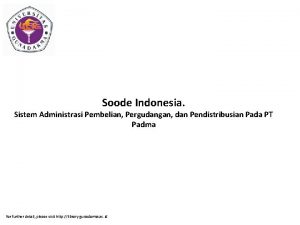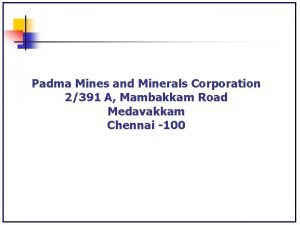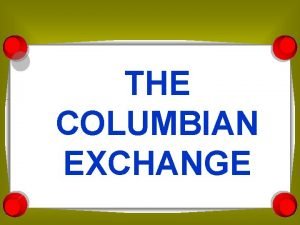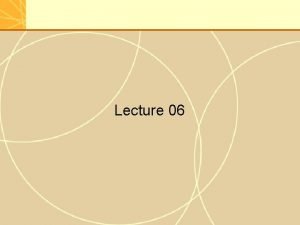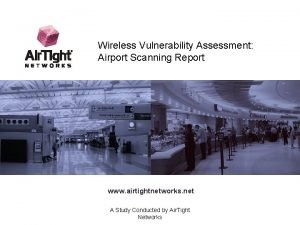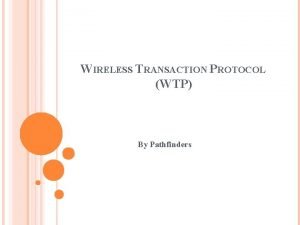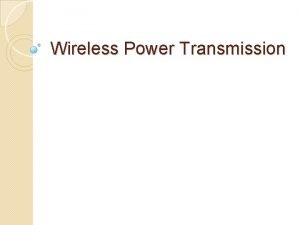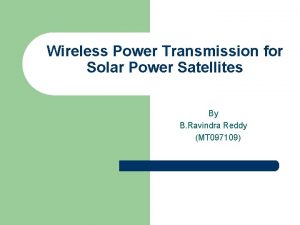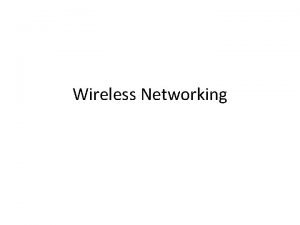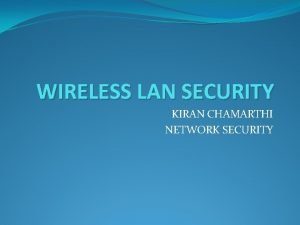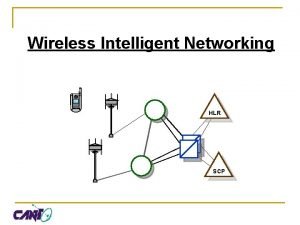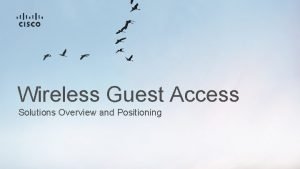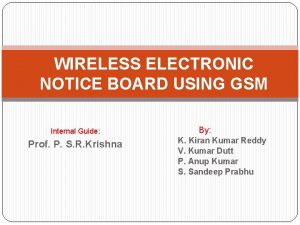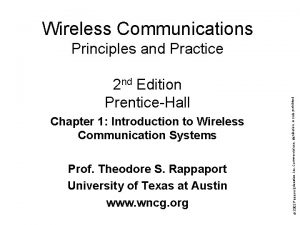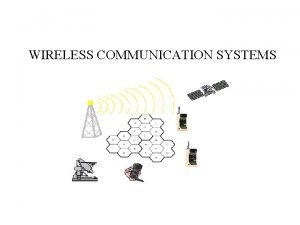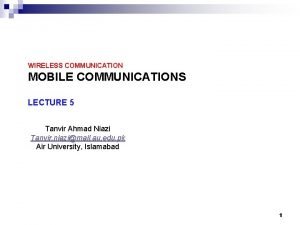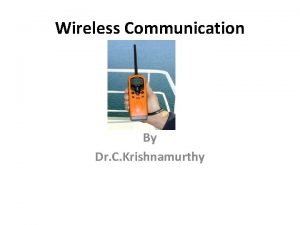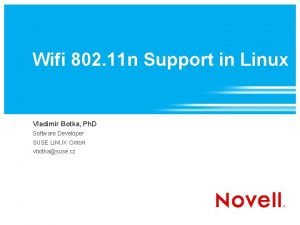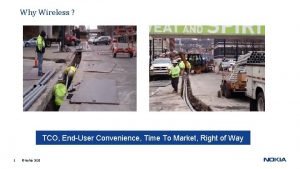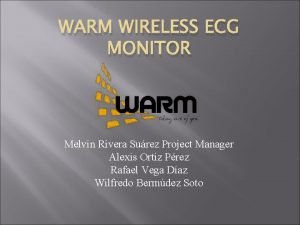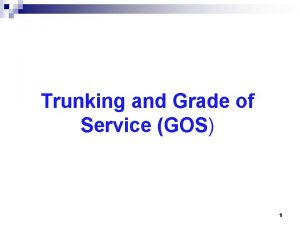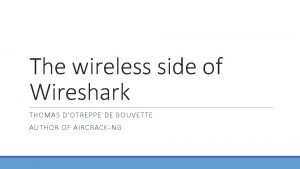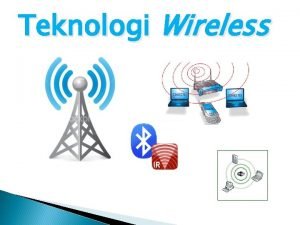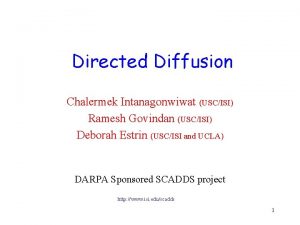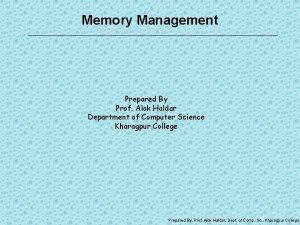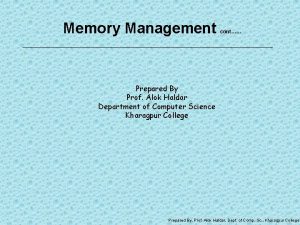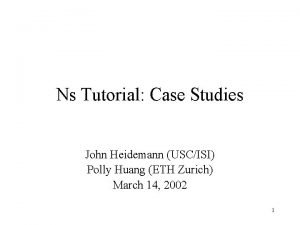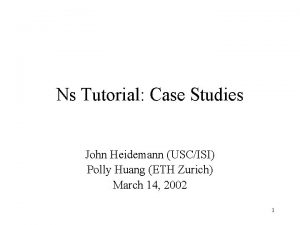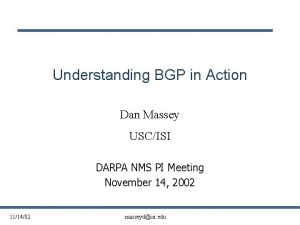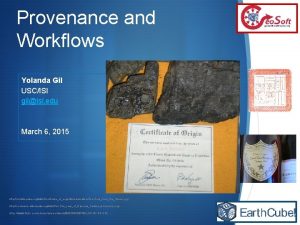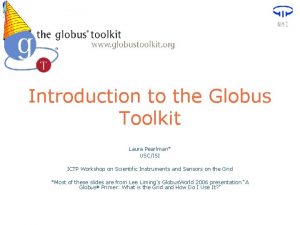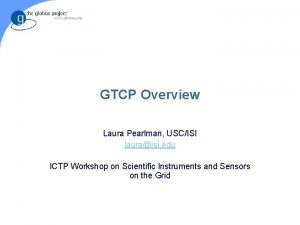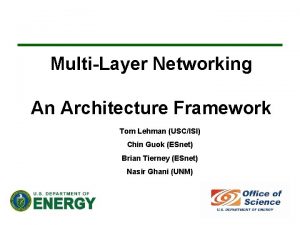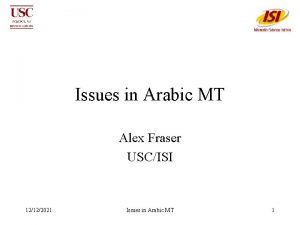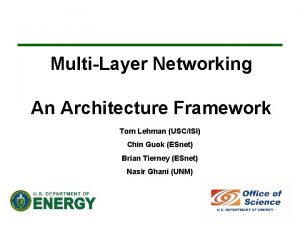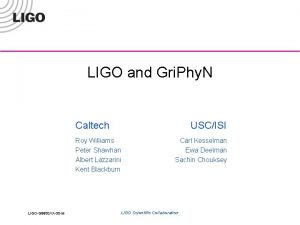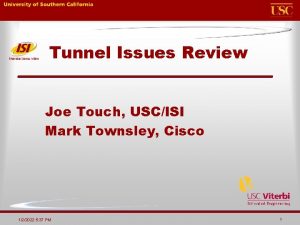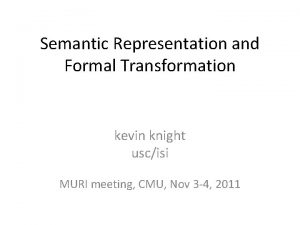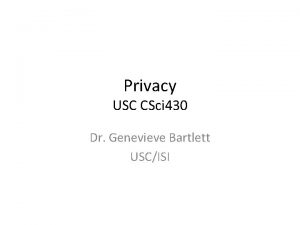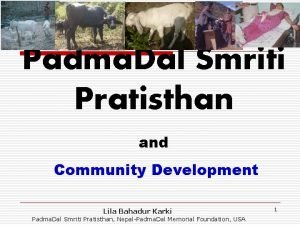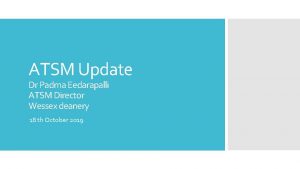Wireless world in NS Padma Haldar USCISI 1








![Example –Step 3 ¡ Create God set god [create-god 3] $ns at 900. 00 Example –Step 3 ¡ Create God set god [create-god 3] $ns at 900. 00](https://slidetodoc.com/presentation_image_h2/a776d7c1ffa38ead2c486a4b5d0d07d4/image-9.jpg)






![A Traffic Scenario set udp_(0) [new Agent/UDP] $ns_ attach-agent $node_(0) $udp_(0) set null_(0) [new A Traffic Scenario set udp_(0) [new Agent/UDP] $ns_ attach-agent $node_(0) $udp_(0) set null_(0) [new](https://slidetodoc.com/presentation_image_h2/a776d7c1ffa38ead2c486a4b5d0d07d4/image-16.jpg)






















- Slides: 38

Wireless world in NS Padma Haldar USC/ISI 1

Outline ¡ Introduction l l Wireless basics Wireless internals Ad hoc routing ¡ Mobile IP ¡ Satellite networking ¡ Directed diffusion ¡ 2

Contributions to mobility in ns Original mobility model in ns contributed by CMU’s Monarch group ¡ Other major contributions from UCB, Sun microsystems, univ of cincinnati, ISI etc ¡ Other contributed models (not integrated) in wireless ns includes Blueware, Blue. Hoc, Mobiwan, GPRS, CIMS etc ¡ 3

Wireless model ¡ ¡ Mobilenode at core of mobility model Mobilenodes can move in a given topology, receive/transmit signals from/to wireless channels Wireless network stack consists of LL, ARP, MAC, IFQ etc Allows simulations of multi-hop ad hoc networks, wireless LANs, sensor networks etc 4

Wireless Example for ad hoc routing ¡ Scenario l l l ¡ 3 mobile nodes moving within 670 m. X 670 m flat topology using DSDV ad hoc routing protocol Random Waypoint mobility model TCP and CBR traffic ns-2/tcl/ex/wireless-democsci 694. tcl 5

An Example – Step 1 # Define Global Variables # create simulator set ns [new Simulator] # create a flat topology in a 670 m x 670 m area set topo [new Topography] $topo load_flatgrid 670 6

An Example – Step 2 # Define standard ns/nam trace # ns trace set tracefd [open demo. tr w] $ns trace-all $tracefd # nam trace set namtrace [open demo. nam w] $ns namtrace-all-wireless $namtrace 670 7

GOD (General Operations Director) Stores smallest number of hops from one node to another ¡ Optimal case to compare routing protocol performance ¡ Automatically generated by scenario file ¡ set god [create-god <no of mnodes>] ¡ $god set-dist <from> <to> <#hops> 8 ¡
![Example Step 3 Create God set god creategod 3 ns at 900 00 Example –Step 3 ¡ Create God set god [create-god 3] $ns at 900. 00](https://slidetodoc.com/presentation_image_h2/a776d7c1ffa38ead2c486a4b5d0d07d4/image-9.jpg)
Example –Step 3 ¡ Create God set god [create-god 3] $ns at 900. 00 “$god setdist 2 3 1” 9

An Example – Step 4 # Define how a mobile node is configured $ns node-config -adhoc. Routing DSDV -ll. Type LL -mac. Type Mac/802_11 -ifq. Len 50 -ifq. Type Queue/Drop. Tail/Pri. Queue -ant. Type Antenna/Omni. Antenna -prop. Type Propagation/Two. Ray. Ground -phy. Type Phy/Wireless. Phy -channel. Type Channel/Wireless. Channel -topo. Instance $topo -agent. Trace ON -router. Trace OFF -mac. Trace OFF 10

An Example – Step 5 # Next create a mobile node, attach it to the channel set node(0) [$ns node] # disable random motion $node(0) random-motion 0 # Use “for” loop to create 3 nodes: for {set i < 0} {$i < 3} {incr i} { set node($i) [$ns node] $node($i) random-motion 0 } 11

Mobilenode Movement Node position defined in a 3 -D model ¡ However z axis not used ¡ $node set X_ <x 1> $node set Y_ <y 1> $node set Z_ <z 1> $node at $time setdest <x 2> <y 2> <speed> ¡ Node movement may be logged 12

Scenario Generator: Movement ¡ Mobile Movement Generator setdest -n <num_of_nodes> -p pausetime -s <maxspeed> -t <simtime> -x <maxx> -y <maxy> Source: ns-2/indep-utils/cmu-scengen/setdest/ ¡ Random movement l l $node random-motion 1 $node start 13

A Movement File $node_(2) set Z_ 0. 000000 $node_(2) set Y_ 199. 373306816804 $node_(2) set X_ 591. 256560093833 $node_(1) set Z_ 0. 000000 $node_(1) set Y_ 345. 357731779204 $node_(1) set X_ 257. 046298323157 $node_(0) set Z_ 0. 000000 $node_(0) set Y_ 239. 438009831261 $node_(0) set X_ 83. 364418416244 $ns_ at 50. 000000 "$node_(2) setdest 369. 463244915743 170. 519203111152 3. 371785899154" $ns_ at 51. 000000 "$node_(1) setdest 221. 826585497093 80. 855495003839 14. 909259208114" $ns_ at 33. 000000 "$node_(0) setdest 89. 663708107313 283. 494644426442 19. 153832288917" 14

Scenario Generator: Traffic ¡ Generating traffic pattern files CBR/TCP traffic ns cbrgen. tcl [-type cbr|tcp] [-nn nodes] [seed] [-mc connections] [-rate] l CBR traffic ns cbrgen. tcl –type cbr –nn 20 –seed 1 –mc 8 - rate 4 l TCP traffic ns cbrgen. tcl –type tcp -nn 15 -seed 0 –mc 6 l ¡ Source: ns-2/indep-utils/cmu-scen-gen/ 15
![A Traffic Scenario set udp0 new AgentUDP ns attachagent node0 udp0 set null0 new A Traffic Scenario set udp_(0) [new Agent/UDP] $ns_ attach-agent $node_(0) $udp_(0) set null_(0) [new](https://slidetodoc.com/presentation_image_h2/a776d7c1ffa38ead2c486a4b5d0d07d4/image-16.jpg)
A Traffic Scenario set udp_(0) [new Agent/UDP] $ns_ attach-agent $node_(0) $udp_(0) set null_(0) [new Agent/Null] $ns_ attach-agent $node_(2) $null_(0) set cbr_(0) [new Application/Traffic/CBR] $cbr_(0) set packet. Size_ 512 $cbr_(0) set interval_ 4. 0 $cbr_(0) set random_ 1 $cbr_(0) set maxpkts_ 10000 $cbr_(0) attach-agent $udp_(0) $ns_ connect $udp_(0) $null_(0) $ns_ at 127. 93667922166023 "$cbr_(0) start" ……. 16

An Example – Step 6 # Define node movement model source <movement-scenario-files> # Define traffic model source <traffic-scenario-files> 17

An Example – Step 7 # Define node initial position in nam for {set i 0} {$i < 3 } { incr i} { $ns initial_node_position $node($i) 20 } # Tell ns/nam the simulation stop time $ns at 200. 0 “$ns nam-end-wireless 200. 0” $ns at 200. 0 “$ns halt” # Start your simulation $ns run 18

Energy Extension Node is energy-aware ¡ Define node by adding new options: ¡ $ns_ node-config –energy. Model Energy. Model -initial. Energy 100. 0 -tx. Power 0. 6 -rx. Power 0. 2 19

nam Visualization ¡ Use nam to visualize: l l l Mobile node position Mobile node moving direction and speed Energy consumption at nodes (color keyed) 20

nam Visualization ¡ Replace $ns namtrace-all $fd with $ns namtrace-all-wireless $fd At the end of simulation, do $ns nam-end-wireless [$ns now] 21

Outline ¡ Introduction l l Wireless basics Wireless internals Ad hoc routing ¡ Mobile IP ¡ Satellite networking ¡ Directed diffusion ¡ 22

Wireless Internals ¡ Mobilenode l l ¡ Basic node that has address and port de-muxes, routing agent etc Stack of network components consisting of LL, MAC, Net. IF radiomodel etc Wireless channel 23

Portrait of A Mobile Node port classifier protocol agent Classifier: Forwarding 255 addr classifier defaulttarget_ LL Agent: Protocol Entity routing agent ARP Node Entry LL IFQ IFQ: Interface queue MAC: Mac object PHY: Net interface MAC PHY Mobile. Node CHANNEL Propagation and antenna models LL: Link layer object Prop/ant Radio propagation/ antenna models 24

Mobile Node : Components ¡ Classifiers • • ¡ defaulttarget_ points to routing agent object 255 is the port id assigned for rtagent_ Routing agent • May be ad hoc routing protocol like AODV, DSDV or directed diffusion 25

Mobile Node: Components ¡ Link Layer l l ¡ ARP l l ¡ Same as LAN, but with a separate ARP module Sends queries to ARP Resolves IP address to hardware (MAC) address Broadcasts ARP query Interface queue l l Gives priority to routing protocol packets Has packet filtering capacity 26

Mobile Node: Components ¡ MAC l 802. 11 IEEE RTS/CTS/DATA/ACK for unicast ¡ Sends DATA directly for broadcast ¡ l ¡ SMAC (work in progress) Network interface (PHY) l l l Used by mobilenode to access channel Stamps outgoing pkts with meta-data Interface with radio/antenna models 27

Mobile Node: Components ¡ Radio Propagation Model l ¡ Friss-space model – attenuation at near distance Two-ray ground reflection model for far distance Shadowing model -probabilistic Antenna l Omni-directional, unity-gain 28

Wireless Channel Duplicate packets to all mobile nodes attached to the channel except the sender ¡ It is the receiver’s responsibility to decide if it will accept the packet ¡ l l Collision is handled at individual receiver O(N 2) messages grid keeper, reference-copying etc 29

Grid-keeper: An Optimization 30

Mobile Node: Misc. Energy consumption model for sensor networks ¡ Visualization of node movement, reachability, and energy ¡ Validation test suites ¡ 31

Wireless Trace Support Original cmu trace format ¡ A separate wireless trace format developed later at ISI ¡ Current ongoing effort to have ONE format to combine all wired and wireless formats ¡ 32

Ad Hoc Routing ¡ Four routing protocols currently supported: DSDV ¡ Contributed by CMU l DSR ¡ Contributed by CMU; recently updated l AODV ¡ Recently updated version from univ. of cincinnati; l TORA ¡ Contributed by CMU Examples under tcl/test-suite-wireless{ lan-newnode. tcl, lan-aodv. tcl, lantora. tcl } l ¡ 33

A Brief on Mobile. IP Support ¡ Developed by Sun l l ¡ Wired-cum-wireless extension l ¡ Base-stations, support hier-rtg Standard Mobile. IP l ¡ Require a different Node structure than Mobile. Node Co-exists with wired world in ns Home Agent, Foreign Agent, Mobile. Hosts Example Under tcl/test-suite-wireless-lannewnode. tcl (tests: DSDV-wired-cum-wireless and DSDV-wireless-mip) 34

A Brief on Satellite Networking Developed by Tom Henderson (UCB) ¡ Supported models ¡ l l ¡ Geostationary satellites: bent-pipe and processing-payload Low-Earth-Orbit satellites Example: tcl/ex/sat-*. tcl and tcl/test-suite-satellite. tcl 35

A Brief on Directed Diffusion ¡ ¡ Developed by SCADDS group at USC/ISI Diffusion model in ns consists of l l l ¡ ¡ ¡ A core diffusion layer A library of APIs for diffusion applications Add-on filters (for gradient routing, logging, tagging, srcrtg, GEAR etc) Much in development Source code in ~ns/diffusion 3 Examples under tcl/ex/diffusion 3 and test/test-suite-diffusion 3. tcl 36

SMAC ¡ ¡ ¡ SMAC – MAC designed for sensor networks Similar RTS/CTS/DATA/ACK like 802. 11 Additional sleep-wakeup cycles Reduce energy consumptions during idle phases Much in development Examples under tcl/test-suite-smac. tcl 37

Summary ¡ ¡ ¡ Wireless support in ns continuously evolving Directed diffusion and SMAC – work in progress Other contributed models (not integrated into ns distribution) : l l Mobiwan, GPRS, Bluehoc and blueware, CIMS etc Find at ns’ contributed code page at http: //www. isi. edu/nsnam/ns/nscontributed. html 38
 Padma soode
Padma soode Padma mines and minerals corporation
Padma mines and minerals corporation Padma bhushan award
Padma bhushan award Hardee's commercials sexist
Hardee's commercials sexist Padma kamath
Padma kamath Padma award
Padma award Dr padma mishra bhopal
Dr padma mishra bhopal Telecommunications, the internet, and wireless technology
Telecommunications, the internet, and wireless technology Purgatorius
Purgatorius Are oranges old world or new world
Are oranges old world or new world Real world vs digital world
Real world vs digital world Allegory of the cave examples in real life
Allegory of the cave examples in real life Ap world history chapter 25 africa and the atlantic world
Ap world history chapter 25 africa and the atlantic world The changing world output and world trade picture
The changing world output and world trade picture Bad world tour
Bad world tour Sour cream walls is an example of pun
Sour cream walls is an example of pun Awarding the world its world
Awarding the world its world World world
World world The changing world output and world trade picture
The changing world output and world trade picture Rob ratterman
Rob ratterman Wireless vulnerability assessment
Wireless vulnerability assessment Wtp wireless
Wtp wireless Advantages and disadvantages of wireless power transmission
Advantages and disadvantages of wireless power transmission Wireless power transmission project report doc
Wireless power transmission project report doc Wireless networking definition
Wireless networking definition Wireless security definition
Wireless security definition Scp wike
Scp wike Wireless guest access solution
Wireless guest access solution Wireless electronic notice board using gsm
Wireless electronic notice board using gsm Wireless communication introduction
Wireless communication introduction Paging in wireless communication
Paging in wireless communication Umbrella cell approach
Umbrella cell approach Advantages of wireless transmission
Advantages of wireless transmission Replace crda with core/wireless-regdb?
Replace crda with core/wireless-regdb? Wireless presentation tco
Wireless presentation tco Wireless ecg project
Wireless ecg project Grade of service
Grade of service Thomas d'otreppe
Thomas d'otreppe Wireles artinya
Wireles artinya
